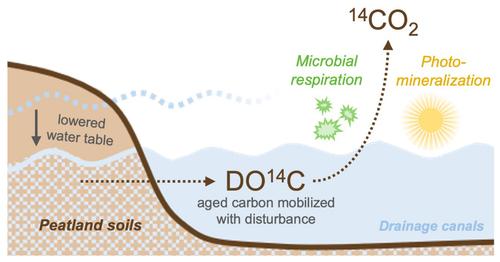当前位置:
X-MOL 学术
›
Glob. Change Biol.
›
论文详情
Our official English website, www.x-mol.net, welcomes your feedback! (Note: you will need to create a separate account there.)
Aquatic processing enhances the loss of aged carbon from drained and burned peatlands
Global Change Biology ( IF 10.8 ) Pub Date : 2024-07-11 , DOI: 10.1111/gcb.17394 Jennifer C Bowen 1, 2 , Alison M Hoyt 2 , Xiaomei Xu 3 , Muhammad Nuriman 4 , Gusti Z Anshari 4, 5 , Putri Juliandini Wahyudio 4 , Lihini I Aluwihare 1
Global Change Biology ( IF 10.8 ) Pub Date : 2024-07-11 , DOI: 10.1111/gcb.17394 Jennifer C Bowen 1, 2 , Alison M Hoyt 2 , Xiaomei Xu 3 , Muhammad Nuriman 4 , Gusti Z Anshari 4, 5 , Putri Juliandini Wahyudio 4 , Lihini I Aluwihare 1
Affiliation

|
Water‐logged peatlands store tremendous amounts of soil carbon (C) globally, accumulating C over millennia. As peatlands become disturbed by human activity, these long‐term C stores are getting destabilized and ultimately released as greenhouse gases that may exacerbate climate change. Oxidation of the dissolved organic carbon (DOC) mobilized from disturbed soils to streams and canals may be one avenue for the transfer of previously stored, millennia‐aged C to the atmosphere. However, it remains unknown whether aged peat‐derived DOC undergoes oxidation to carbon dioxide (CO2 ) following disturbance. Here, we use a new approach to measure the radiocarbon content of CO2 produced from the oxidation of DOC in canals overlying peatland soils that have undergone widespread disturbance in Indonesia. This work shows for the first time that aged DOC mobilized from drained and burned peatland soils is susceptible to oxidation by both microbial respiration and photomineralization over aquatic travel times for DOC. The bulk radiocarbon age of CO2 produced during canal oxidation ranged from modern to ~1300 years before present. These ages for CO2 were most strongly influenced by canal water depth, which was proportional to the water table level where DOC is mobilized from disturbed soils to canals. Canal microbes preferentially respired older or younger organic C pools to CO2 , and this may have been facilitated by the use of a small particulate organic C pool over the dissolved pool. Given that high densities of canals are generally associated with lower water tables and higher fire risk, our findings suggest that peatland areas with high canal density may be a hotspot for the loss of aged C on the landscape. Taken together, the results of this study show how and why aquatic processing of organic C on the landscape can enhance the transfer of long‐term peat C stores to the atmosphere following disturbance.
中文翻译:

水产加工增加了排水和燃烧泥炭地中老化碳的损失
浸水的泥炭地在全球范围内储存了大量的土壤碳 (C),在数千年的时间里不断积累碳。随着泥炭地受到人类活动的干扰,这些长期碳储存变得不稳定,最终作为温室气体释放,可能加剧气候变化。从受干扰的土壤转移到溪流和运河中的溶解有机碳(DOC)的氧化可能是将先前储存的千年碳转移到大气中的一种途径。然而,目前尚不清楚老化泥炭来源的 DOC 是否会氧化成二氧化碳(CO 2 )扰动后。在这里,我们使用一种新方法来测量 CO 的放射性碳含量2泥炭地上方的运河中 DOC 氧化而产生,泥炭地土壤在印度尼西亚遭受了广泛的干扰。这项工作首次表明,从排水和燃烧的泥炭地土壤中动员的老化 DOC 很容易被微生物呼吸和 DOC 水生传播时间的光矿化氧化。 CO 的整体放射性碳年龄2运河氧化过程中产生的物质范围从现代到大约 1300 年前。 CO 的这些年龄2受运河水深的影响最为强烈,运河水深与地下水位成正比,DOC 从受扰动的土壤迁移至运河。运河微生物优先将较老或较年轻的有机碳池呼吸成二氧化碳2 ,这可能是通过在溶解池上使用小颗粒有机碳池来促进的。 鉴于高密度的运河通常与较低的地下水位和较高的火灾风险相关,我们的研究结果表明,高运河密度的泥炭地地区可能是景观中老化碳流失的热点地区。总而言之,本研究的结果表明,景观中有机碳的水生加工如何以及为何能够增强长期泥炭碳储存在干扰后向大气的转移。
更新日期:2024-07-11
中文翻译:

水产加工增加了排水和燃烧泥炭地中老化碳的损失
浸水的泥炭地在全球范围内储存了大量的土壤碳 (C),在数千年的时间里不断积累碳。随着泥炭地受到人类活动的干扰,这些长期碳储存变得不稳定,最终作为温室气体释放,可能加剧气候变化。从受干扰的土壤转移到溪流和运河中的溶解有机碳(DOC)的氧化可能是将先前储存的千年碳转移到大气中的一种途径。然而,目前尚不清楚老化泥炭来源的 DOC 是否会氧化成二氧化碳(CO 2 )扰动后。在这里,我们使用一种新方法来测量 CO 的放射性碳含量2泥炭地上方的运河中 DOC 氧化而产生,泥炭地土壤在印度尼西亚遭受了广泛的干扰。这项工作首次表明,从排水和燃烧的泥炭地土壤中动员的老化 DOC 很容易被微生物呼吸和 DOC 水生传播时间的光矿化氧化。 CO 的整体放射性碳年龄2运河氧化过程中产生的物质范围从现代到大约 1300 年前。 CO 的这些年龄2受运河水深的影响最为强烈,运河水深与地下水位成正比,DOC 从受扰动的土壤迁移至运河。运河微生物优先将较老或较年轻的有机碳池呼吸成二氧化碳2 ,这可能是通过在溶解池上使用小颗粒有机碳池来促进的。 鉴于高密度的运河通常与较低的地下水位和较高的火灾风险相关,我们的研究结果表明,高运河密度的泥炭地地区可能是景观中老化碳流失的热点地区。总而言之,本研究的结果表明,景观中有机碳的水生加工如何以及为何能够增强长期泥炭碳储存在干扰后向大气的转移。
















































 京公网安备 11010802027423号
京公网安备 11010802027423号